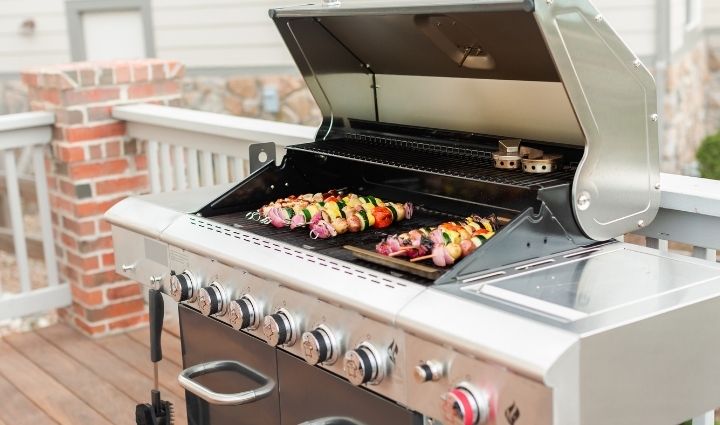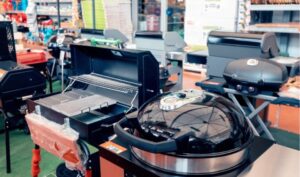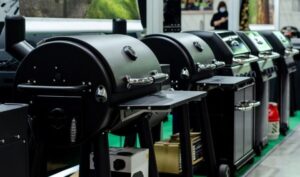This is Part 2 of GrillSpot’s Ultimate Gas Grill Buying Guide, where we’ll cover everything you need to know about how to buy a gas grill, from what factors you need to consider to detailed guides dedicated to everything from budget to grill size to BTUs.
It’s probably pretty clear that gas grills run on gas. But there are actually many different types of gas grills, and the differences between each one—and their advantages and disadvantages—may not be quite so obvious.
It’s important to understand the differences between types of gas grills because while they do all use gas to generate heat, they are not interchangeable. Due to their unique molecular properties, different gases have different pressures that require differently sized openings, so you can’t alternate between propane and natural gas without buying a new grill or investing in a conversion kit that allows you to alternate. Plus, not all grill brands offer or are compatible with conversion kits.
In this section of our Ultimate Gas Grill Buying Guide, we will explore the differences in four gas grill types to help you determine which gas grill type is the best fit for you, including:
- Propane gas grills
- Natural gas grills
- Charcoal-gas hybrid grills
- Infrared gas grills
We’ll also take a closer look at different styles of gas grill.
Let’s begin.
1. Propane Gas Grills
Propane gas grills run on propane, which is a byproduct of natural gas processing and oil refining. Propane gas has a low boiling point, which makes it a popular fuel for grilling and powering other portable machines and vehicles, such as forklifts.
Propane gas is purchased, exchanged, or refilled in refillable tanks (also called cylinders) at various locations, such as hardware stores, grocery stores, corner stores, gas stations and other local propane distributors. If you have an in-ground propane tank, your grill can also be set up to draw from it, but this requires a special regulator.
GRILL FACT: Propane gas expands when the temperature rises and can be released from the tank if it has no room to expand, so propane containers are required by law to have an overfill prevention device that prevents the tank from being filled more than 80%.
The propane tank hooks up to your grill via a hose and sits in, beneath, or beside the grill’s body. When hooking up the propane tank to your grill, inspect the tank to confirm it has no damage—the tank valve gasket should be round and not have any cracks, and the hose should be free of damage or cracks as well. Be sure to consult your owner’s manual to confirm your tank is installed properly and check for leaks before grilling.
GRILL SPOT TIP: A twenty pound propane tank offers about 25 hours of grilling time in warm months, but less in the winter, so it is always good to keep more than one tank on hand when it gets cold.
Advantages
- Quick and easy to start—no need to prepare charcoal
- Easy to maintain
- Can be used anywhere as long as you have a propane tank
- Offers enough grilling space for a crowd
Disadvantages
- The food’s flavor may not taste as smoky as charcoal
- Can be expensive compared to some other options
- Large sizes require more space
- Can run out of fuel while cooking if the tank level is not closely monitored
- Propane tanks have to be refilled from time to time
Who should buy a propane gas grill?
The portability of the tanks makes propane gas grills convenient for small, compact, portable grilling, so if taking your grill to the beach or park, or over to a family cookout is an important factor, a propane grill is probably right for you.
2. Natural Gas Grills
Natural gas grills run on—you guessed it—natural gas, which is a naturally occurring product of decomposition made up of a mixture of gases (primarily methane) that are extracted from the ground.
Natural gas grills boast two notable benefits: their fuel costs less and, because they hook up to your home’s natural gas line, they do not require you to replace tanks. That means you never have to worry about running out in the middle of a grill sesh because they are hooked up to a fixed gas line.
Most natural gas grills come complete with a kit for hooking up the grill to your gas line, but you may still have to pay for the installation of a natural gas line from your home to your grill. If your home is not heated by natural gas and does not have a natural gas line that runs to your house, the cost becomes considerably steeper, especially if your home is a significant distance from the distribution line. If this is the case, you are better off opting for a propane gas grill.
Advantages
- Quick and easy to start—no need to prepare charcoal
- Easy to maintain
- Never run out of fuel
- Offers enough grilling space for a crowd
Disadvantages
- The food’s flavor may not taste as smoky as charcoal
- Can be expensive compared to some other options
- Large sizes require more space
- Have to be in proximity to a natural gas line
Who should buy a natural gas grill?
Natural gas grills are ideal for people whose homes are already heated by natural gas.
Compare propane and natural gas grills.
3. Charcoal-Gas Hybrid Grills
For the griller who doesn’t want to choose between charcoal and gas, there is the hybrid or combo grill. These grills run off of propane gas and charcoal, which means they offer the same benefits of a propane grill with the added bonus of that charcoal smokey goodness so many BBQ fans love. These grills typically have two separate lids (one for each fuel) but a single grilling space, so it is easy to use both charcoal and gas simultaneously. Some hybrid setups require a few steps to convert between fuel types, but it’s usually just the installation of a briquette tray.
Advantages
- Offers both the convenience of gas and flavor of charcoal
- Quick and easy to start
Disadvantages
- May have to sacrifice cooking surface to accommodate the two types
- Can be bulkier than single fuel grills
- Can run out of fuel while cooking if the tank and charcoal level is not closely monitored
- Propane tanks have to be refilled from time to time
Who should buy a charcoal-gas hybrid grill?
A hybrid grill is the perfect choice for grillers who want both charcoal and gas options but don’t have the space for more than one grill.
4. Infrared Gas Grills
Infrared gas grills use a radiant heat cooking system, as opposed to the convection cooking system used by most traditional gas grills. While a standard gas grill heats the air to produce an ambient temperature inside the grill and the heated air is what cooks your food, infrared gas grills heat only solid objects—like a piece of meat—rather than the air surrounding them. This allows them to get up to temperature more quickly and cook food faster.
There are different types of infrared burner systems, such as ceramic burners (the most common), radiant glass panels, and heat emitter systems. Hybrid infrared gas grills are available as well. Different systems are ideal for different types of cooking—ceramic burners, for example, are ideal for searing hot and fast, but are not ideal for grilling at lower temperatures. Heat emitter systems, on the other hand, produce less heat and will not reach the maximum searing temperature of ceramic or radiant class burner systems.
Due to their high-heat capabilities, these grills are best for cooking items that need to be seared at a high temperature like steak, but you have to be an attentive griller because things can quickly overcook. Infrared grills can be quite costly, so consider carefully whether this is the right grill for you.
GRILL SPOT TIP: If you’re not ready or interested in fully committing to an infrared gas grills, many standard gas grills come with infrared burners or can be equipped with infrared burner add-ons.
Advantages
- Excellent searing capabilities
- Fast cooking times
- Unlikely to experience flare-ups
- Quick and easy to start
- Gets up to temperature quickly
Disadvantages
- High heat means you have to be an attentive griller
- Less versatile than other grill options
- Can be expensive
Who should buy an infrared grill?
Infrared grills are best for those who love fast grilling, searing and cooking steaks. Otherwise, you’re better off with a grill that offers infrared features in addition to more general grilling capabilities.
Styles of Gas Grills
Regardless of the type of gas grill fuel or delivery method you prefer, each type of gas grill comes with a variety of cooking surfaces, configurations, and sizes:
Cooking surface
Gas grills typically come with grates, but there are different types of grates and some alternative cooking surfaces to consider:
Flat tops or griddles
Flat tops are easy to clean, hold heat well, and can cook many more things than just BBQ (like breakfast foods). They’re also great for searing and caramelizing. If you don’t want to buy a dedicated flat top grill, you can opt simply to buy a griddle accessory that fits into your grill setup.
Grates
Grates are the most popular cooking surface for a grill. Grates create those classic criss-cross sear-marks and produce some of the best barbecue. Grill grates are commonly made from three materials:
- Stainless steel grill grates: Of all the grates, stainless steel are the least susceptible to rust, but they still require some care on occasion. Thankfully, they are typically the easiest to clean and maintain.
- Enamel or porcelain-coated steel grill grates: Like stainless steel grill grates, enamel or porcelain-coated steel grates are easy to clean and maintain, but they are more susceptible to rust if the coating is chipped. Proper maintenance and routine care with soft cleaning implements is required to maximize the lifetime of these grill grates.
- Cast iron grill grates: Cast iron is favored by many chefs. It offers excellent heat retention and an even cooking temperature. The downside is that they require seasoning, so if you’re not willing to put in a little extra work, you may wish to consider a different type of grate.
Learn more about How to Clean Your Grill’s Cooking Grates.
Configuration
Gas grills come in a variety of different setups:
Portable gas grills: Portable gas grills always run on propane. Typically the smallest grill size, portable gas grills are well-suited to small home setups, renters, camping trips, and tailgate parties.
Freestanding gas grills: These grills are set on a wheeled cart with cupboards for grilling accessories and propane tank storage. Because they’re mobile, they are easy to store and are perfect for yards that can accommodate a larger grill, but you may need or want to move them into storage to create more space or a cleaner look.
Built-in gas grills: Also known as drop-ins and grill inserts, built-in grills can be either propane or natural gas grills that are placed in an outdoor kitchen island. These are permanent fixtures, so they are best suited to larger yards and outdoor kitchen spaces that can accommodate an immovable fixture.
Size
Whether you prefer gas or charcoal (or a combo), grill sizes are pretty standard across the different fuel types. Using the helpful burger-patty-based size classification system created by Consumer Reports, grills can be divided into three categories:
- Small grills: Holds 18 or fewer burger patties. Often portable, these grills are perfect for small cookouts and are ideal if you don’t have a lot of space to store your grill (or a lot of room in your budget).
- Mid-sized grills: Holds between 18 to 28 burger patties. This is the most popular grill size for a reason, mid-sized grills are often the sweet spot for size, features, and price range for most grillers.
- Large grills: Holds 28 or more burger patties. With a huge cooking area and often the highest cost, these grills are usually for serious grillers only.
Conclusion
After looking at four different gas grill types—propane, natural gas, charcoal-gas hybrid, and infrared—their cooking surfaces, configurations, and sizes, we hope you have a clearer picture of the different grills, their pros and cons, and which one is the right grill for you.
Need help selecting your grill? Visit the How to Choose a Gas Grill section of our guide.
Learn more about gas grills in The Complete Gas Grill Guide.





